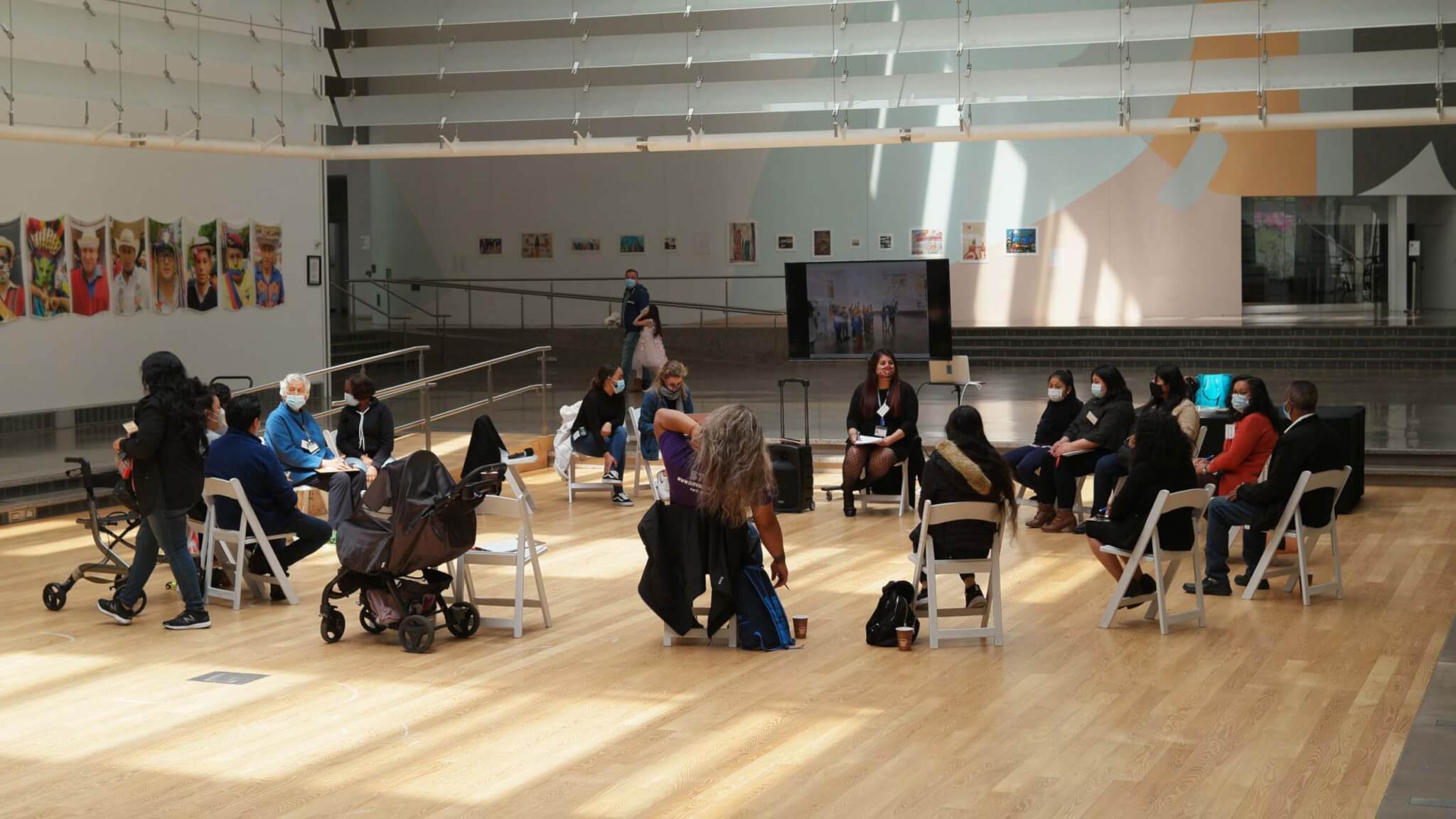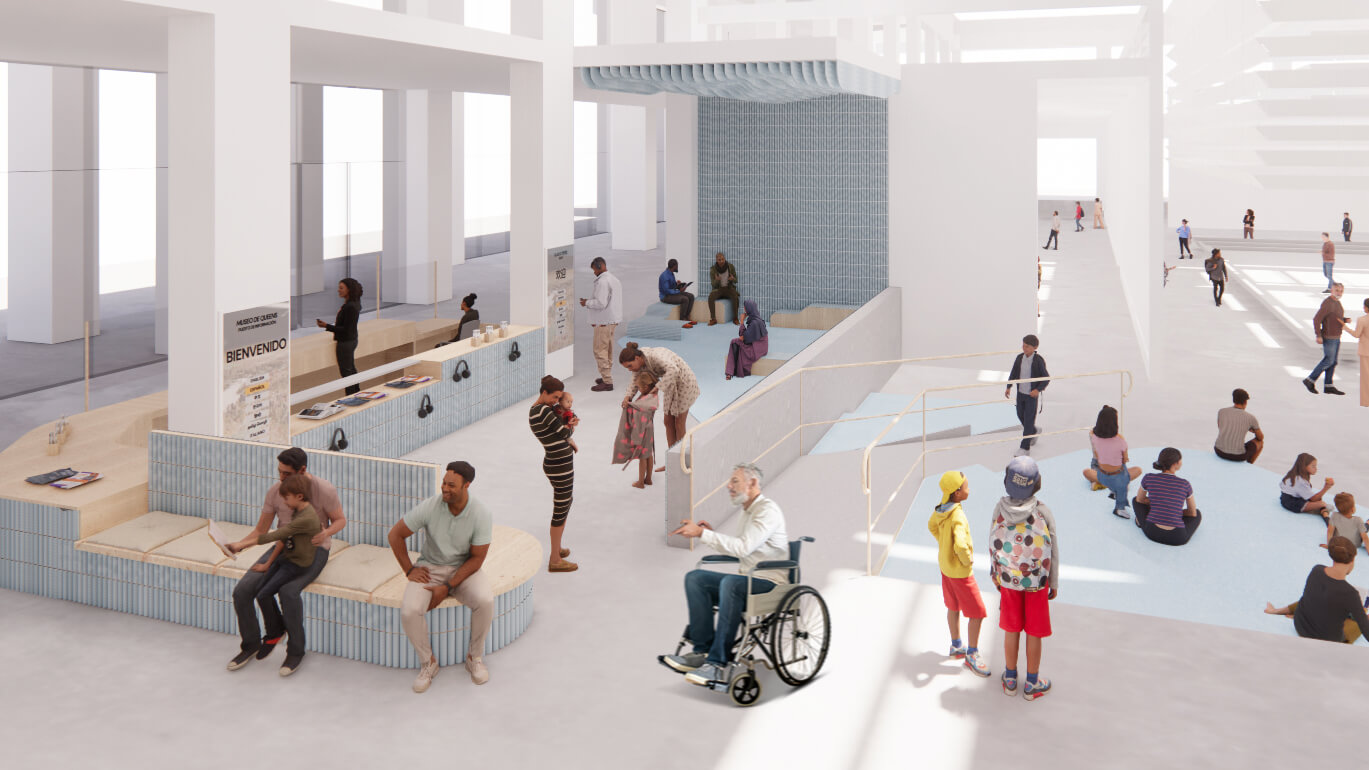On January 26, The Architectural League hosted Joel Sanders and Seb Choe of Joel Sanders Architect (JSA)/MIXdesign to share their ongoing work on the MIXmuseum Study, a design research project initiated in 2018 that investigates the design consequences of diversity, equity, inclusion, and access (DEIA) in the museum context. After their presentation, they spoke with panelists from the Brooklyn Museum; Cooper Hewitt, Smithsonian Design Museum; Whitney Museum of American Art; and Queens Museum about the challenges of making museums more accessible. The conversation was moderated by Ignacio G. Galán, an assistant professor of architecture at Barnard College and Columbia GSAPP.
Though the report related to the MIXmuseum Study will be released this year, JSA/MIXdesign has completed other reports that center the benefits of participatory design processes. Last year, its report for the Queens Museum, titled Central Atrium for All, was released and is available on the museum’s website.
AN’s Executive Editor, Jack Murphy, spoke with Sanders and Choe after their lecture to learn more about the lessons from this report and how a broader idea of accessibility sets the stage for better multisensory experiences for everyone.
AN: How did MIXdesign emerge from the work of JSA?
Joel Sanders (JS): For me, it began in 1996 with the publication of STUD: Architectures of Masculinity, which inaugurated my interest in looking at the relationship between gender and space through what we would now call a queer lens. Then in 2015, national controversies about transgender access to public restrooms motivated me to think about this social justice issue through a wider lens that considers not only gender but the intersecting needs of people of different ages, races, religions, and disabilities. What began with a coauthored essay published in the South Atlantic Quarterly grew into Stalled!—an initiative that made recommendations about safe bathrooms for everyone.
JSA then established MIXdesign in 2018 as an inclusive design studio. We work with progressive clients to help them meet their DEIA goals by looking at the spatial implications of these issues. Beyond working as architects for primarily institutional clients, now we’re also working in partnership with other architectural offices, which we actually find to be gratifying, and we’re writing toolkits that could then be applied to the site- and culture-specific needs of our clients.
Seb Choe (SC): Stalled! served as a spin-off moment. We had created a body of design research that we posted on an open-source website, which many people thought was valuable. Museums and university campuses were a natural evolution because of Joel’s scholarship and our office’s experience working on these kinds of projects.
Applying a lesson learned in Stalled!—the need to bridge theory and practice—made us realize that inclusive design couldn’t be thought about only in the abstract; the work required concrete case studies and participatory design. For our work with museums, we wanted to have the effort grounded in partnerships with specific institutions and participatory processes that combined cross-disciplinary research with the ground-up, lived experiences that these museums were going through.
AN: Can you talk about MIXdesign’s work for the Queens Museum?
SC: A grant from the Institute for Museum and Library Services allowed us to expand our initial pilot study into a two-year participatory design process with the Queens Museum’s staff and members of their community. The process centered around stakeholder and community engagement: We conducted surveys, held a number of public programs, and offered professional-development trainings so the staff could become more literate in accessibility practices.
In addition, we recruited an Access Cohort. It was composed of 25 members who represented a cross section of the museum’s diverse audience, including native Spanish speakers, trans and nonbinary folk, users of wheelchairs, and older adults. They participated in a series of design workshops and focus groups. Collectively, they identified barriers to access and then proposed spatial recommendations or interventions that could address those barriers.
The findings divide the building or the user journey into different activities and spaces. At each step along the way, there were spatial recommendations made by the Access Cohort that were then iterated upon with design proposals by architecture and public health graduate students at Yale. The outcome is a report available to the public on the Queens Museum website. Rather than acting as an authoritative document filled with guidelines, the report chronicles what emerged and tries to be transparent about the process that generated these findings. It invites more inquiry and critique. There is a coda at the end of each section that asks, “What did we miss? Where is there room for growth and more research?”
JS: More broadly, what changed for me, as a senior architect who was taught to work in a particular way, is that I feel like I need to almost unlearn almost everything that I was taught to do. I was persuaded by the power of participatory design. We talked to stakeholders, identified the problem, and then we as architects, in conjunction with students, generated “recommendations” that could be used as the starting point for renovations to the Queens Museum. It wasn’t so much that we as architects came up with these solutions but that they instead emerged from a participatory design process. That process is what I’m most proud of, because that is what is essential in the report.
AN: The report for the Queens Museum focused on four non-gallery spaces: the entry, reception, wellness, and the central atrium. Did anything unique or surprising emerge out of this participatory process for how to improve these spaces?
SC: Thinking about the word “unique,” one thing we’re always thinking about is what advice is generalizable versus what is specific. The report is called Central Atrium for All because this type of space is ubiquitous in many museums. This multipurpose space is activated by events of different sizes; it’s a space that tries to be everything, but in the process, maybe it doesn’t do any of them especially well. For example, on a regular day, school groups don’t have anywhere to sit when they’re going on tours, and children become overstimulated because of all the light and sound. But then the museum might host an event like Queens Museum’s Lunar New Year celebration, where over 300 people attended. This fast shift in programming is something we addressed through spatial recommendations, but it’s also an issue of staffing protocols.
JS: The participatory design process led to surprising insights that encouraged us to think beyond functionalism. For example, at a focus group composed of people with physical disabilities, the discussion focused on making the atrium accessible with additional ramps. But what really stuck with me was one of the participants, a wheelchair user, who said, “You could add all the ramps in the world to this space, but I’m not coming back here.” Why? She said because “the way you’re hanging the art [high on the wall] here, I have to crane my neck. And it’s not that my neck hurts but that it sends a message that says I am invisible to you; the museum doesn’t recognize that I exist.” This comment led the Access Cohort to come up with a new idea: What if instead of one horizon line for wheelchair users, there were multiple pedestals and hanging heights that reflected people of different ages and heights? What if coming to the museum was a multisensory experience that asked all of us to step out of our customary ways of being in the world and have sensory and embodied experiences—and even cultural experiences—that represent these different perspectives? That was an aha moment.
SC: From suggestions such as these we learned that functional and social accessibility are intertwined. Functional accommodations that make buildings physically accessible for a wheelchair user or a low-vision person don’t work if a sense of belonging was missing in the first place. It was a surprise for us to learn that these two issues are related.

AN: What feedback did the museum have about the report?
SC: The Queens Museum was thrilled to receive the report and see our two-year collaboration documented for use both as an internal resource as well as a public offering. They even began to implement some of the recommendations before the report was complete. For example, there was one space that was acoustically reverberant, and it caused sensory overload for visitors with sensory sensitivities as well as staff. They reclad the floor with some carpet tiles left over from an event and closed a wall that was previously open to the main atrium. They also switched restroom signage to focus on fixtures and not gender, a relatively inexpensive change compared to altering spatial layouts. Considering less resource-intensive options is useful, because museums are always asking us about low-hanging fruit they might go after to begin making improvements.
JS: I initially resisted the idea of “low-hanging fruit,” considering them just Band-Aids or quick fixes. I came to realize that my response reflected a bias of my training: The architect must introduce large-scale alterations to leave their mark. But my mind has been changed by the inclusive design process. Now, we offer clients a menu of recommendations—some are quick fixes, while others are more labor intensive and require more time and money. It’s less about uniqueness and more about trying to solve systemic issues.
AN: What is urgent for your museum clients?
SC: All of our museum clients want to improve their buildings so their exhibitions and programs can be more accessible and welcoming for diverse audiences. Although this is a well-intentioned desire, putting it into practice requires a great deal of soul-searching and conflict resolution, not only in how the facility is treated in terms of architectural interventions, but also shifting the way museums make inclusive design decisions. It’s daunting but required of them to rethink everything—the staffing, protocols, and language, everything down to how wall text is written.
This soul-searching that many museums are doing to rethink their purpose must be considered within the larger interrogation of museum funding that’s going on right now, as well as the extreme underfunding of arts and culture. Often there are people in leadership and staff who have the vision but just don’t have the resources to implement it. The movements of museum workers unionizing is another important aspect, as well as the movement to decolonize the museum as an entire apparatus. Museums are beginning to examine their origins and are considering the repatriation of artworks and stolen plunder. These are all interrelated struggles and movements.
JS: Design recommendations alone aren’t enough: Their implementation depends on changing institutional cultures so that inclusive design values are completely integrated. And this insight is not specific to museums alone. We need to bridge the gap between theory and practice. Implementing inclusive design requires designers to think holistically about a wide range of practical, economic, governance, and cultural issues. That is what is so rewarding about the work. It becomes real when you have an actual client. It involves working with real people in a real space and an actual building. That’s where the real work happens.

